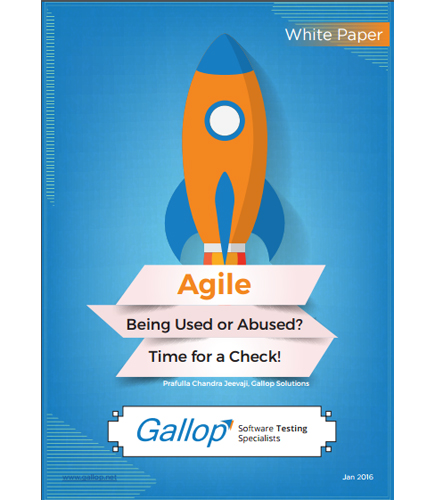
PROCESSING. PLEASE WAIT...


White Paper: Gallop Solutions
Implementing an Agile development methodology successfully requires the clear understanding of the consequences of agile approaches. Loose implementation of agile methodology can hold you back in reaping the benefits of agile implementation.
Why agile development methodology? What are the Benefits of Agile Methodology?
Agile methodology has an impressive track of record in delivering success to large companies in developing innovative products and services. Implementing Agile methodology will have some benefits such as cost control, flexibility, building the right product and generates high revenue.
Why do we need agile software development?
Agile software development in the true spirit and rigor would yield into the right results and help in reaping the benefits. Agile implementation leads to successful completion of project, bringing great justice to the organization in the long run.
Agile or Fragile? Use or Abuse? Indeed time for a check!
According to a recent survey 49% of agile projects are not being done on time or have over planned budget, while 9% of the projects are total failures. Implications of loosely implementing Agile is that as an organization you are definitely not reaping the benefits of Agile implementation in terms of reduced time to market, reduced development cost, and so on.
Download this white paper to find whether Agile is indeed being implemented properly and in the true spirit, or as per their convenient method under the wrapper of Agile?
By: L&T Infotech
Every organization should have well-organized and effective testing strategies in order to increase test efficiency and deliver high quality software. Test data is one of the most important factors in overall testing life cycle. Scenario-specific, realistic, right-sized, masked test data created in test environments ensures the following: - Scenario-specific test data availability before test execution increases test efficiency/quality and reduces overall testing cycle time. - Realistic test data in lower test regions reduces production defect leakages. - Right-sized test data in test environments reduces space utilization and increases the response time. - Masked test data ensures security compliance
By: QA Mentor
Why is it significant to properly manage test environments? How should we do it? What are the best practices and strategies to use test environment management tools and services? Test environment management strategy involves guiding and managing the test environment hardware, software, databases, applications, and test data. Slowed testing and inconsistent results are caused by poorly managed environments while problematic, testing issues are caused by inadequate test data management. Most test environment issues can be boiled down by proper test environment management. In order to manage test environment efficiently, the following are necessary: A dedicated Test Environment Management (TEM) team. Defining the team terminology and sticking to it. Creating an easily accessible knowledge base. Defining the test environment strategy. Improving efficiency and productivity in testing. Test management tools that can assist the TEM. Download this whitepaper to build a stronger, better managed test environment which brings a reduction in production issues, increased productivity, and higher customer satisfaction rates.


 2025 All Rights Reserved | by: www.ciowhitepapersreview.com
2025 All Rights Reserved | by: www.ciowhitepapersreview.com